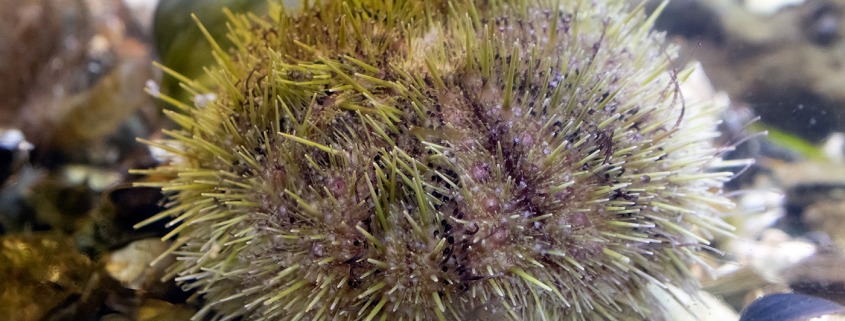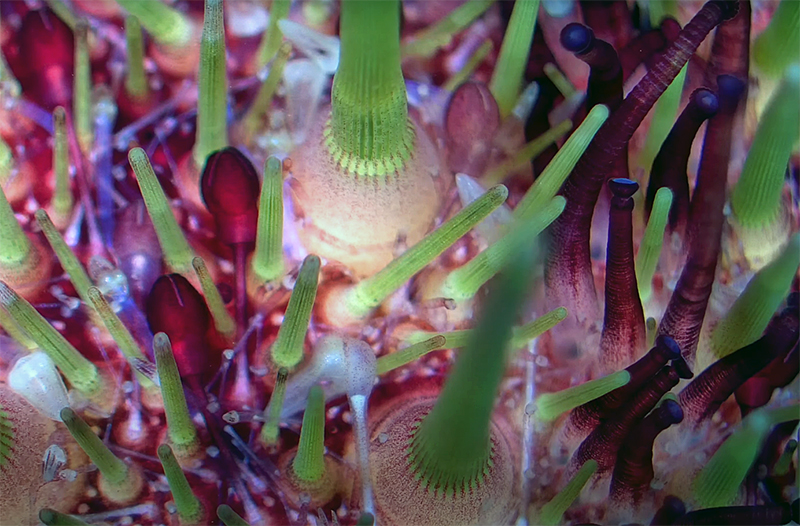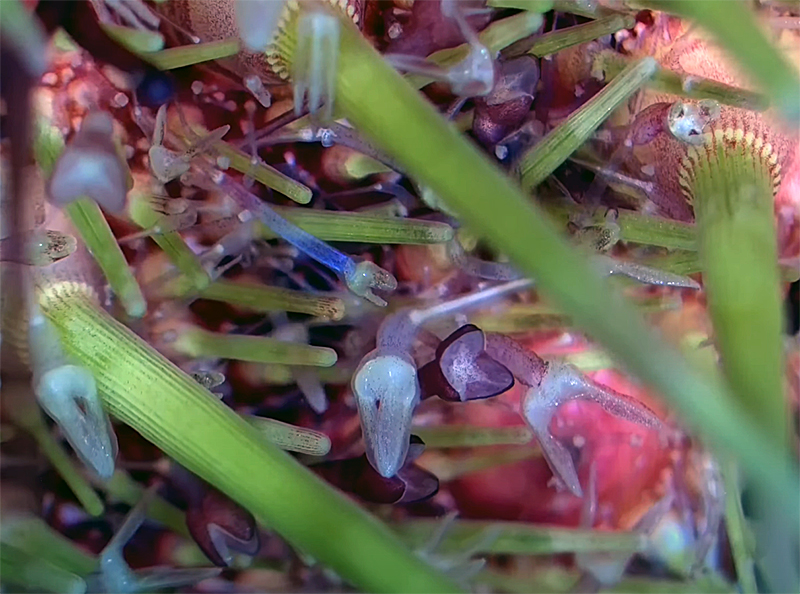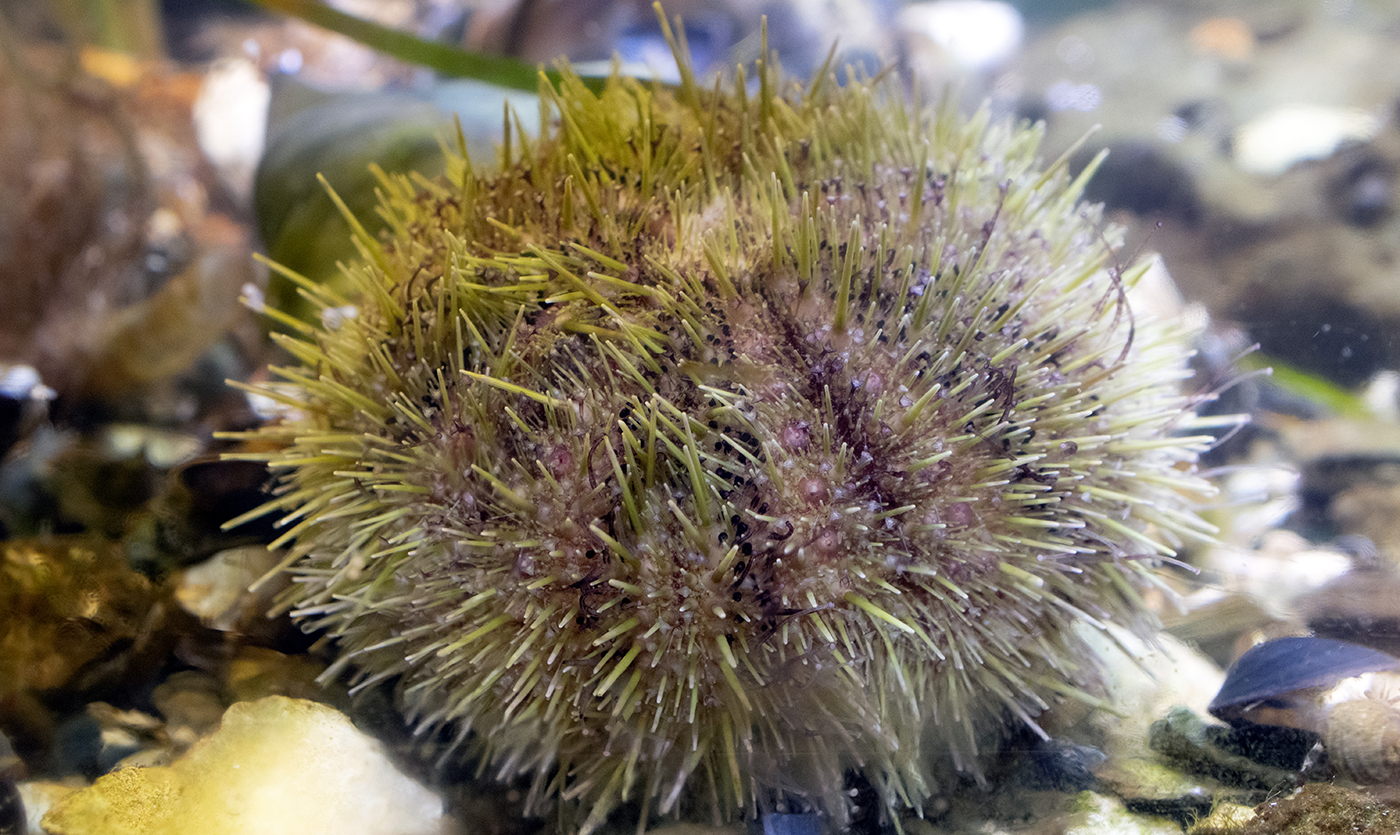Green Sea Urchin
Author: Martina Sarra
Scientific Name: Strongylocentrotus droebachiensis
Size Range:the average adult size is 50 mm (2 in), but it has been recorded at a diameter of 87 mm (3.4 in).
Identifying Features The Green Sea Urchin can appear dull green, yellow-green or, generally, greenish-brown: light green at base of the spines and lighter toward the tip; vertical rows of tube feet usually appear as dark bands and the test is usually purple to violet rather than green.
The brittle “shell”, or test, is comparatively small, low but not flat, reaching a width of 8 cm; the short blunt spines crowd close together and are 1 to 5 cm long. The outer epidermis is made up of a single layer of ciliated cells equipped with tiny moveable hairs (cilia) which cover all external parts including all the appendages (spines and pedicellariae). These help take food towards the mouth as well as sweep waste away from the urchin.
A nerve network is situated beneath the epidermis but outside the test. Each spine and pedicellaria has a nerve ring around the base with branches travelling up the length.
Habitat: A widespread Arctic and northern boreal species; from the Arctic Ocean to Washington and the Sea of Japan in the Pacific, and from Hudson Bay, Greenland, Iceland, northern Europe to Chesapeake Bay, USA, Scotland and the western part of Baltic Sea in the Atlantic. Adults live in cold climates in water temperatures from 0 to 15 degrees Celsius and are found on rocky or gravel shorelines from the intertidal zones to about 1200 meters (about 4000 ft) deep.
This creature uses its strong Aristotele’s lantern (special teeth structure) to burrow into rock/ sand-stone, and then can widen its home with the spines. They can leave their hole to find food and then return, but sometimes it creates a hole that gets bigger as it gets deeper. The Strongylocentrotus droebachiensis is a euryhaline species, and can survive in waters of low salinity. This allows it to flourish in the south Puget Sound.
Food Sea urchins feed primarily on fixed algae and depends on season and locality, but also on small gastropods, barnacles, dead fish, diatoms, and detritus. They use their sense of smell to locate food, detecting chemicals given off by their prey. Most of the animals they eat are attached to the substrate, like sea squirts, hydroids and sponges. The pedicellariae are also able to paralyze small animals and larvae, or grab the hairs of some crustaceans, allowing the urchin to capture live food. In the fall we often see large kelps covered with sea urchins munching away on their tissues. They use their spines and tube feet to grab pieces of the algae then manoeuvre them down to the jaws that protrude through the mouth at regular intervals to tear off smaller pieces. The digestive tract is the most obvious organ in the interior of the test and supports an astonishing assortment of ciliated protozoans, most of which seem to be commensals feeding on bacteria in the gut. From the mouth, it passes through the lantern as the pharynx. It emerges from the top as the esophagus and forms a short loop. Then it becomes the small intestine, it doubles back on itself and expands into the large intestine, exiting at the anus. The sharp tips of the five jaws that make up a structure called Aristotele’s lantern chop the food into tiny fragments which can be swallowed and digested for whatever nutritional value they have.
Predators Despite their protective spines, some predators routinely prey on sea urchins. Vertebrates that eat sea urchins include Sea Otters, crows, gulls, Wolf-eels and other large fish. Sea stars and crabs are the main invertebrate predators. Sea urchins use their spines and pedicellariae to defend themselves. The pedicellariae react when something foreign touches the surface of the urchin. They can be aggressive or defensive.
Of all the predators humans are probably the most devastating. People in many parts of the world (Mediterranean, Peru, Ecuador, Japan) consider the sea urchin’s ripe gonads a delicacy. The Green Urchin is known to be eaten by the Native peoples of New Brunswick from archaeological remains.
Life cycle: Sea urchins are dioecious, meaning they either contain male or female reproductive organs: they contain five gonads tucked under the test, protected by genital place. Sea urchins all release their ripe individuals shed eggs or sperm directly into the water column at the same time to ensure fertilization.
In temperate regions most spawning takes place in the spring and summer, and some sea urchins brood their young.
Once fertilized, the gamete grows via mitosis and eventually becomes a larva capable of simple swimming called an echinoplutes. The metamorphosis is hugely complex. At the end of the process the sea urchin settles down to a benthic life.
In the San Juan Islands individuals can be ripe from January to June with a peak in spawning from March to April. Eggs are usually 155-160 micrometer in diameter. At 9-10°C the embryo reaches the plates stage in five days and metamorphoses into a juvenile urchin in 9 or 10 weeks. The test reaches a diameter of one centimetre in about a year. All these values can vary depending on temperature and food supply.
Conservation Status: The green sea urchins and its habitat are not in any way threatened by the environment. However, if green sea urchins were to be reduced in population, there would be mass amounts of kelp that would cause the water to be congested. This situation does not allow boats to pass through the water.
References:
Bannister, D., D. Campbell. 1985. The Encyclopedia of Aquatic Life. http://animaldiversity.org/accounts/Strongylocentrotus_droebachiensis/
Kozloff, E. (1993). Seashore life of the northern Pacific coast: An illustrated guide to Northern California, Oregon, Washington, and British Columbia. Seattle, Washington: University of Washington Press.
Lamb, A. and Hanby, B. P. (2005). Marine Life of the Pacific Northwest: A photographic encyclopedia of invertebrates, seaweeds and selected fishes. Harbour.
Lambert, P. and C. Austin, W. (2007). Brittle Stars: Sea Urchins and Feather Stars of British Columbia, southeast Alaska and Puget Sound. Royal BC Museum.
Snively, G. (1978). Exploring the Seashore in British Columbia, Washington and Oregon: A guide to shorebirds and intertidal plants and animals. Gordon Soules Book Publishers.
Valiela, I. 1995. Marine Ecological Processes. http://animaldiversity.org/accounts/Strongylocentrotus_droebachiensis/








Leave a Reply
Want to join the discussion?Feel free to contribute!